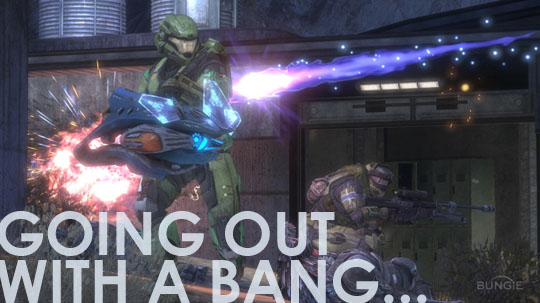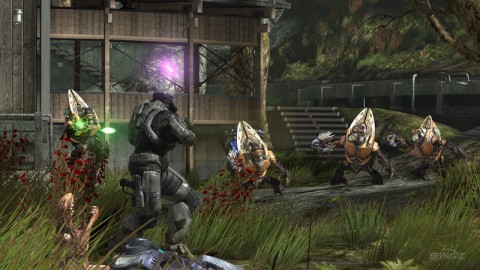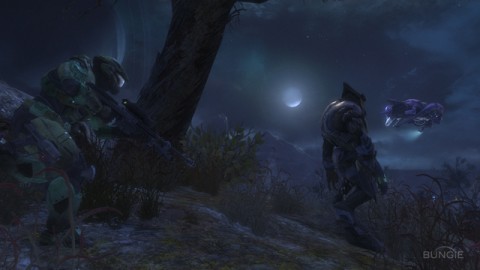Halo: Reach – a review and a fond farewell
A Fond Farewell
When Halo: Reach was announced as a prequel, a lot of gamers expressed their concerns,making comparisons to Lucas’s critical failure with the Star Wars movie prequels. This totally ignores that one of the defining differences between film and video games is that it’s pretty hard to make a game worse than the original. Unless, as a developer, you’re completely phoning it in, a large part of the art of game making, as opposed to film making, is tweaking the elements of gameplay, not just making the graphics prettier. In the case of Halo: Reach, it’s clear that Bungie wanted to leave their franchise on a high note. Even though those of us familiar with the storyline know how it ends, we know that the fall of Reach was only the beginning.
Telling The Story
The original Halo: Combat Evolved, was a pretty straight forward space epic, that for me, captured the kind of scope that was found in Heinlein’s Starship Troopers (nothing like the movie). Other than the 3rd instalment, Bungie has experimented somewhat with their storytelling methods in the past, the most effective being the multiple human roles in Halo 3: ODST, complete with flashbacks. In Reach, the storytelling is more straightforward, as you play the new UNSC Spartan on the block, Noble 6, who’s replacing a fallen squad member for Noble team.
Unlike the stoic Master Chief, Noble 6 really is part of a team, and as the larger story unfolds, we get some glimpses into the other characters. They’re not the kind of in-depth personas you’ll find in a game like Mass Effect, but it’s enough to get you to care about (at least some) of them. The combination of cutscenes and in game comments from the non-player characters delivers a well-paced balance between telling a story and keeping the action going. Whenever a cutscene was delivered, I never felt the urge to skip ahead, which is no small feat in its own right.
That being said, even with the cutscenes, the story is a little, well, Spartan. Personally I liked the flow and use of flashbacks in Halo 3: ODST, and while the story of Reach doesn’t call for such techniques, I felt that sometimes the connective thread between missions was a little strained. I can’t come down too hard on Bungie for this tough, because ultimately it’s an FPS, and there’s nothing like a developer who thinks so highly of their own story that they’ll force you to sit through agonizing hours of dime store dialogue because you need to know WHY you’re shooting the bad guy.
The right balance between story and action works well in part due to the new engine built for Halo: Reach, which delivers some stunning visuals, especially in the brief cutscenes of flyovers to your next tactical locations. They provide a perfect segue between the cutscene and the gameplay. The new engine has certainly been beefed up compared to previous instalments and it shows. Though there is the occasional framerate issue, it’s a minor occurrence, and the colour and scope of the visuals more than make up for it.
Singleplayer Campaign
Like the story, the gameplay is rarely revolutionary. It still feels like Halo, but with more polish. Bungie has taken the abilities first introduced in Halo 3: ODST, and made them reusable Armour Abilities, as first seen in the multiplayer beta. In straight up FPS combat, the best part is the new Covenant A.I. Even the lowly Grunts, who have always been pretty much cannon fodder, have some survival instincts. The Elites are equipped with the same armour abilities as the Spartans, and they actually use them well. I first learned this deadly lesson while trying to run down an Elite who then punched the ground to activate the Armor Lock, destroying the vehicle and sending me flying in the air to my death. Live and learn, as they say. A true testament to the balance Bungie has found is that I have yet to feel cheated by the game when I die. Every time I’ve taken a dirt nap, it was my own stupidity, making me rethink my approach to the mission at hand. There’s often more than one approach to a mission, and finding your own style of play is a large part of what makes the single player game so satisfying.
The Warthog is also back, as well as other vehicles that long time Halo players will be familiar with. We’re also introduced to a few new vehicles as well, and
Multiplayer Gameplay
The game just launched, and even though I’ve been reviewing it for the past week, I’ve only had a few hours of multi-player under my belt. From playing it at pre-release events and the beta, I can safely say that I suspect that Halo: Reach is going to shoot to the top of the Xbox LIVE most played games online. Depending on release schedules, it’s generally a toss-up between a Halo title and a Call Of Duty title for top spot. When playing Reach in multiplayer, it struck the same balance as Quake 2, my personal favourite all time multiplayer FPS.
All the usual suspects are there, but the two points worth noting are the much more polished version of “Firefight” mode, where Spartans fight increasingly difficult waves of A.I. foes. In a new variation, opposing players can take on the role of Covenant Elite, out to put an end to the Spartan run. Polished to a high sheen as well is Forge World, another addition first seen in ODST, and now given the royal treatment. The new Forge World is easier to manipulate, and gives map builders more intuitive controls over a larger feature set, giving the multiplayer fan a lot of tools to keep the game fresh for a long time to come.
Overall
Back at the beginning of this article, I mentioned that the movie/game comparisons aren’t generally a good idea, because they are two different mediums. Reach makes one of the strongest cases for that, not because it’s ground-breaking, or going to convince skeptics that games can be art, but that gameplay is both an art and a science in its own right. Bungie called the original Halo Combat Evolved, which it truly was, proving that an FPS could be not only work on a console, but deliver its own experience different than a PC shooter. Every bit of Reach feels as if that evolution was the mantra, taking the best parts of the previous versions and building on that initial promise.
Bungie may have left the Halo franchise for new endeavours, but they left it, and their fans, with a grand farewell, the best incarnation of the Halo universe, and a lot of digital toys for multiplayer fans to play with for a long time to come.



















[…] This post was mentioned on Twitter by Doug Groves, rgbFilter. rgbFilter said: Halo: Reach – a review and a fond farewell: A Fond Farewell When Halo: Reach was announced as a prequel, a lot of … http://bit.ly/aW9sD4 […]